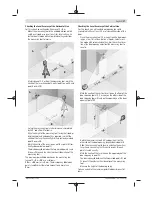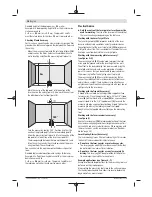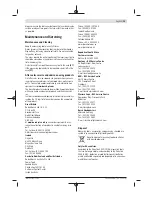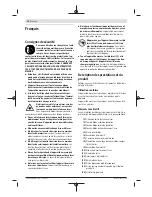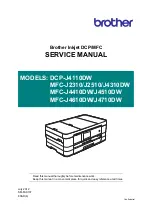
16
| English
1 609 92A 4HM | (19.11.2018)
Bosch Power Tools
Working without Automatic Levelling
For work without automatic levelling, slide the on/off
switch
(12)
to the "
On
" position. When automatic levelling
is switched off, the laser lines continuously flash slowly.
If you switch off the automatic levelling system, you can hold
the measuring tool freely in your hand or set it down on a
sloping surface. This means that the laser lines are no longer
necessarily running perpendicularly to one another.
Accuracy Check of the Measuring Tool
Influences on Accuracy
The largest influence is exerted by the ambient temperature.
In particular, temperature differences that occur from the
ground upwards can refract the laser beam.
Since the temperature stratification is greatest at ground
level, you should always mount the measuring tool on a tri-
pod for measuring distances of 20 m or more. In addition,
position the measuring tool in the centre of the work surface,
wherever this is possible.
In addition to external influences, device-specific influences
(e.g. falls or heavy impacts) can also lead to deviations. For
this reason, check the levelling accuracy each time before
beginning work.
First check the height accuracy and levelling accuracy of the
horizontal laser line, then the levelling accuracy of the ver-
tical laser line.
If the measuring tool exceeds the maximum deviation in one
of the checks, it should be sent to the Bosch after-sales ser-
vice for repair.
Checking the Height Accuracy of the Horizontal Line
For this check, you will need a free measuring distance of
5
m on firm ground between two walls (designated A and B).
– Mount the measuring tool close to wall A on a tripod, or
place it on a firm, level surface. Switch on the measuring
tool. Select cross-line mode with automatic levelling.
A
B
5 m
– Aim the laser at the closer wall A and allow the measuring
tool to level in. Mark the middle of the point at which the
laser lines cross on the wall (point I).
A
B
180°
– Turn the measuring tool 180°, allow it to level in and mark
the point where the laser lines cross on the opposite wall
B (point
Ⅱ
).
– Position the measuring tool – without rotating it – close to
wall B, switch it on and allow it to level in.
A
B
– Align the height of the measuring tool (using the tripod or
by placing objects underneath as required) so that the
point where the laser lines cross exactly hits the previ-
ously marked point
Ⅱ
on wall B.
d
180°
A
B
– Turn the measuring tool 180° without adjusting the
height. Aim it at wall A such that the vertical laser line runs
through the already marked point
Ⅰ
. Allow the measuring
tool to level in and mark the point where the laser lines
cross on wall A (point
Ⅲ
).
– The discrepancy
d
between the two marked points
Ⅰ
and
Ⅲ
on wall A reveals the actual height deviation of the
measuring tool.
The maximum permitted deviation on the measuring dis-
tance of 2 ×
5
m =
10
m is as follows:
10
m × ±
0.3
mm/m = ±
3
mm. The discrepancy
d
between
points
Ⅰ
and
Ⅲ
must therefore amount to no more than
3
mm.
















